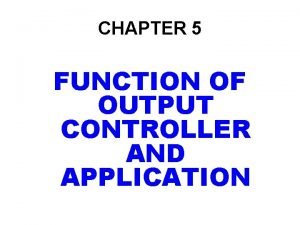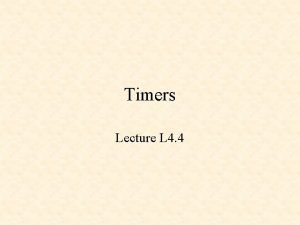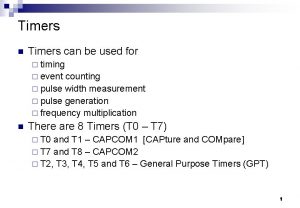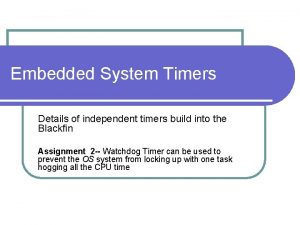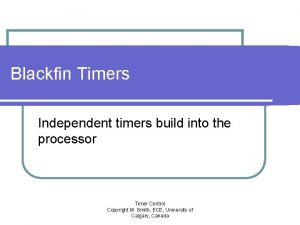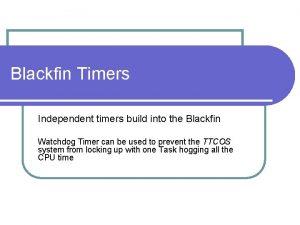CSE 154 LECTURE 19 EVENTS AND TIMERS Anonymous















- Slides: 15

CSE 154 LECTURE 19: EVENTS AND TIMERS

Anonymous function(parameters) { statements; } • Java. Script allows you to declare anonymous functions • quickly creates a function without giving it a name • can be stored as a variable, attached as an event handler, etc. JS

Anonymous function example window. onload = function() { var ok = document. get. Element. By. Id("ok"); ok. onclick = okay. Click; }; function okay. Click() { alert("booyah"); } JS output • or the following is also legal (though harder to read and bad style): window. onload = function() { document. get. Element. By. Id("ok"). onclick = function() { alert("booyah"); }; };

The danger of global variables var count = 0; function incr(n) { count += n; } function reset() { count = 0; } • globals can be bad; other code and other JS files can see and modify them • How many global symbols are introduced by the above code? incr(4); incr(2); console. log(count); JS • 3 global symbols: count, incr, and reset

Enclosing code in a function everything() { var count = 0; function incr(n) { count += n; } function reset() { count = 0; } } incr(4); incr(2); console. log(count); everything(); // call the function to run the code • the above example moves all the code into a function; variables and functions declared inside another function are local to it, not global • How many global symbols are introduced by the above code? • 1 global symbol: everything (can we get it down to 0? )

The "module pattern" (function() { statements; })(); JS • wraps all of your file's code in an anonymous function that is declared and immediately called • 0 global symbols will be introduced! • the variables and functions defined by your code cannot be messed with externally

Module pattern example (function() { var count = 0; function incr(n) { count += n; } function reset() { count = 0; } incr(4); incr(2); console. log(count); })(); • How many global symbols are introduced by the above code? • 0 global symbols JS

Unobtrusive styling function okay. Click() { this. style. color = "red"; this. class. Name = "highlighted"; }. highlighted { color: red; } • well-written Java. Script code should contain as little CSS as possible • use JS to set CSS classes/IDs on elements • define the styles of those classes/IDs in your CSS file JS CSS

Java. Script "strict" mode "use strict"; your code. . . • writing "use strict"; at the very top of your JS file turns on strict syntax checking: • shows an error if you try to assign to an undeclared variable • stops you from overwriting key JS system libraries • forbids some unsafe or error-prone language features • You should always turn on strict mode for your code in this class!

The six global DOM objects Every Javascript program can refer to the following global objects: name document history location navigator screen window description current HTML page and its content list of pages the user has visited URL of the current HTML page info about the web browser you are using info about the screen area occupied by the browser window

Setting a timer method description set. Timeout(function, delay. MS); arranges to call given function after given delay in ms set. Interval(function, delay. MS); arranges to call function repeatedly every delay. MS ms clear. Timeout(timer. ID); stops the given timer clear. Interval(timer. ID); • both set. Timeout and set. Interval return an ID representing the timer • this ID can be passed to clear. Timeout/Interval later to stop the timer

set. Timeout example <button id="clickme">Click me!</button> <span id="output"></span> HTML window. onload = function() { document. get. Element. By. Id("clickme"). onclick = delayed. Message; }; function delayed. Message() { document. get. Element. By. Id("output"). inner. HTML = "Wait for it. . . "; set. Timeout(say. Booyah, 5000); } function say. Booyah() { // called when the timer goes off document. get. Element. By. Id("output"). inner. HTML = "BOOYAH!"; } JS output

set. Interval example var timer = null; // stores ID of interval timer function delay. Msg 2() { if (timer === null) { timer = set. Interval(rudy, 1000); } else { clear. Interval(timer); timer = null; } } function rudy() { // called each time the timer goes off document. get. Element. By. Id("output"). inner. HTML += " Rudy!"; } JS output

Passing parameters to timers function delayed. Multiply() { // 6 and 7 are passed to multiply when timer goes off set. Timeout(multiply, 2000, 6, 7); } function multiply(a, b) { alert(a * b); } JS output • any parameters after the delay are eventually passed to the timer function • doesn't work in IE; must create an intermediate function to pass the parameters • why not just write this? set. Timeout(multiply(6 * 7), 2000); JS

Common timer errors • many students mistakenly write () when passing the function set. Timeout(booyah(), 2000); set. Timeout(booyah, 2000); set. Timeout(multiply(num 1 * num 2), 2000); set. Timeout(multiply, 2000, num 1, num 2); • what does it actually do if you have the () ? • it calls the function immediately, rather than waiting the 2000 ms! JS
 Cse 154
Cse 154 Cse 154
Cse 154 The 8051 has______16-bit counter/timers
The 8051 has______16-bit counter/timers Off delay timer symbol
Off delay timer symbol Operating modes of 8051
Operating modes of 8051 Timer in assembly language
Timer in assembly language Arduino uno logo
Arduino uno logo 24 timers mennesket
24 timers mennesket Cascading timers
Cascading timers 40 timers hms kurs
40 timers hms kurs Steinar solheim
Steinar solheim Lecturel
Lecturel Tmod register
Tmod register Idle timer expired
Idle timer expired 01:640:244 lecture notes - lecture 15: plat, idah, farad
01:640:244 lecture notes - lecture 15: plat, idah, farad Mutually exclusive vs non mutually exclusive
Mutually exclusive vs non mutually exclusive








